|
|
|
Read about the planned reenactment of Tony Jannus' historic flight by
Kermit Weeks, in the Tampa Bay Times
|
The 100 Year Anniversary of Scheduled
Passenger Airline Service
Jan. 1, 2014
|
|
|
Read about the planned reenactment of Tony Jannus' historic flight by
Kermit Weeks, in the Tampa Bay Times
|
ANTONY HABERSACK JANNUS
(1889 - 1917) Even before his history-making flight across Tampa Bay on Jan. 1, 1914, he was a popular and much sought-after figure in aviation. He had gained fame in exhibition flying, long distance flying planes and airboats, testing military planes and weapons, as well as piloting the first flight for a parachute jump--all by 1913. By virtue of his technical education, he was involved in the experimental and design aspects of aviation and became one of the foremost designers of aircraft. By 1913 he had become one of the principal stockholders of Benoist Aircraft Company in St. Louis. Jannus was always the center of attention. His personality, good looks, and talent as a speaker made him a highly desired individual; he often dated movie actresses, and women idolized him, having become the epitome of the romantic flyer. In 1913, Tony Jannus came to St. Pete with his brother Roger, and his mechanic, to pilot Thomas Benoist's "Flying Boat" No. 43 into aviation history. On January 1, 1914, Percival Fansler's "St. Petersburg-Tampa Airboat Line" became the world's first scheduled passenger airline service to use heavier than air aircraft, carrying passengers between the yacht basin in St. Pete and the Hillsborough River in downtown Tampa. The airline operated for four months, during which time Jannus became the bay area's most well-known celebrity. At age 25, he was a bachelor in demand; not wealthy, but well-off financially. He was handsome, with dark, brooding good looks and twinkling eyes. He was certainly capable of turning feminine heads. The whole crew of the St. Pete-Tampa Airboat line, especially Tony, was treated royally in the bay area, especially in St. Pete. According to Eleanor C. Reed, proprietor of the Wigwam Hotel where Jannus lived while in the bay area, "He was so thoughtful of others, and had such a winning personality, that he was constantly being sought after by the girls. He did not know sometimes which way to turn." |
||
|
To avoid confusion with his grandfather and uncle of same name, he will be referred to as Tony in the following narrative. |
|
| By 1880, Tony's grandfather, school teacher Antony H. Jannus (born in Hungary) and grandmother Phoebe (born in England), had settled at 366 Stoughton Street in Washington DC with their sons Frankland (Tony's father), Anthony H., John A. and Stephen. Frankland, the oldest at 27, was an attorney; Stephen was an artist and Anthony and John were students. | Frankland Jannus was born in England in 1853. Around 1884, he married Emeline Carlisle Weightman (born 1857, Washington DC). Frankland and Emeline had sons Roger Weightman Jannus (Dec. 1886) and Antony ("Tony") Habersack Jannus (July 1889). By 1900, the family had moved to the village of Larchmont in Mamaroneck County, NY where they lived with Franklin's 75-year-old mother, Phoebe. |
| By the time Tony was 17, he was attending a technical school back in Washington DC, taking courses in mechanics and engineering. In April of 1910, 20-year-old Tony lived as boarder in the home of John and May Kilgore (John was a scientific photographer for the Smithsonian Museum.) Tony was soon hired by the Emerson Marine Engine Co. in Alexandria, VA. It was around this time that Tony began his interest in flying at College Park, Maryland. | |
|
College Park Airport's origins are firmly tied to early military aviation.
It
was the field's association with numerous creative and often renowned civilian
aviators and inventors that ensured its continued operation. Immediately
following Wilbur Wright's attention-getting military instruction there in 1909,
several civilian aviation companies came to College Park, bringing commercial
enterprise and new technology to the airfield.
The first of these companies was the Rex Smith Aeroplane Company, established by well-known inventor and patent attorney Rexford Smith. With an aero of his own design, Rex Smith made many noteworthy flights over the Washington area. When the Army returned to the airfield in 1911 to establish the first Army Aviation School, Smith was requested to move his hangar with the new Army hangars. With their well-publicized flights around the Washington Monument and the U.S. Capitol, the Rex Smith Aeroplane Company became the center of media activity and the focus of the Washington social elite. They were frequently in the news for entertaining and flying politicians and other well-connected individuals, garnering them much support and publicity. |
|
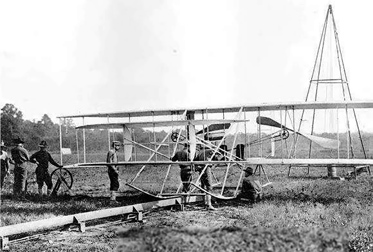
In November of 1910, Rex Smith looked to the Washington DC technical school for students to work at his company. Only two boys out of twenty qualified. Paul Peck, who later became a well-known exhibition flyer, and Tony Jannus. Jannus was sent to the airfield at College Park, Md. to install a marine engine in a modified Curtiss-type airplane made by Frederick Fox and Rex Smith. Tony was instantly obsessed with learning to fly. At time there were no more than twenty known air chauffeurs in America, including the Wright brothers. A Wright Bros. plane at
College Park Airfield, 1909 |
||
|
|
|
|
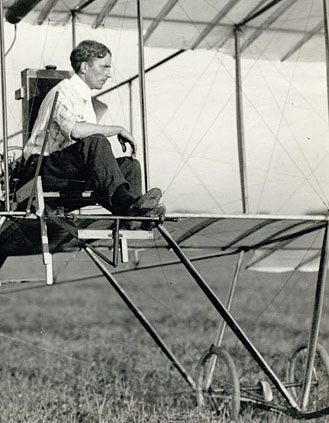
Tom Benoist (photo at left) was St. Louis' first aeronautical entrepreneur, one of the area's first industrialists, and arguably one of this country's true aviation pioneers. Benoist actively participated in all aspects of the new and expanding world of aviation: he designed, manufactured, and marketed airplanes and related hardware; he flew, both as an instructor and as an exhibition flier; he ran an aerial exhibition company and equipped and operated the world's first airline.
By the summer of 1912, Benoist became preoccupied with the notion of flying from water (pioneered in this country by Glenn Curtiss in 1911). Photo from Benoist2014/Missouri Historical Society
|
|||||||
Tony Jannus earned fame as a test pilot and instructor
on March 1,
1912, when he carried Captain Albert Berry aloft to make the first parachute j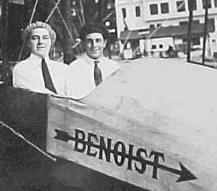 ump
from an airplane. He also piloted the first tests of airborne machine
guns. Jannus flew a number of exhibitions demonstrating Benoist planes
throughout the Midwest and was a contestant at a Chicago air meet in September
1912. Later that month, he established an American passenger-carrying
record by taking three men with him on a 10-minute flight. ump
from an airplane. He also piloted the first tests of airborne machine
guns. Jannus flew a number of exhibitions demonstrating Benoist planes
throughout the Midwest and was a contestant at a Chicago air meet in September
1912. Later that month, he established an American passenger-carrying
record by taking three men with him on a 10-minute flight.
Photo from Screaming Eagle Gallery
(Right) "Aviation history again was made over the City of Flight on March 1, 1912, when Capt. Albert Berry, right, made the first parachute jump from an airplane. The Benoist biplane was piloted by Tony Jannus. The parachute was carried in the cone-like device in the undercarriage, held in by rubber bands which broke under the weight of the jumper." |
|
|
J.D. Smith making repairs, Mississippi River at St. Louis. |
On November 6, 1912, flying an early model Benoist on a single float, Jannus
and his mechanic J.D. Smith, left Omaha for New Orleans in an attempt to set a
distance record for winged aircraft. It took six weeks to make the 1,973 mile
trip down the Missouri and Mississippi rivers because of stops for exhibitions, a near-disastrous
fire, repairs and a bout with appendicitis. Jannus received wide acclaim
in the newspapers as "the pioneer flying-boat pilot of the world." Shortly
thereafter, he was credited with setting a "continuous flight with passenger"
record by flying the 251 miles from Paducah, Ky., to St. Louis in four hours, 15
minutes. In 1913, Jannus participated in a New York Times-sponsored air exhibition. He flew actress Julia Bruns in a Baldwin Red Devil 4,000 ft above Staten Island for twenty minutes on October 12, 1913. The next day, he flew in an air race over Manhattan, the Times reporting that "The graceful Benoist biplane sailed along on an even keel...driven by the famous Tony Jannus" |
| Tony quickly
became a popular figure in aviation. By virtue of his technical education, he
began to get involved in the experimental and design aspects of aviation and
became one of the foremost designers of aircraft. By 1913 he had become
one of the principal stockholders of Benoist Aircraft Company in St. Louis. Jannus was always the center of attention, his personality, good
looks, and talent as a speaker made him a highly desired individual; he often
dated movie actresses, and women idolized him, having become the epitome of the
romantic flyer.
Jannus enjoyed going to movies, and especially ones where airplanes played a role. He was often critical of the obvious substitution of a pilot for the actor and vice versa in the flying scenes, and the awkwardness of the way they handled the machine guns. This disturbed him so much that he began writing scenarios to introduce the airplane to various situations in movies, even comedies. In an interview in 1913, he said "When I see some of the aeroplane work in the movies, it makes me weep and wonder why things are as they are, and at the present moment I am worked up to such a pitch over the misrepresentation that aviation has received in moving pictures that I hope to take a little 'flyer' at it myself. Why shouldn't I, when I have a stable of flying machines at my disposal...and above all, the inclination? In looking around New York, I have observed some opportunities for doing stunts, where the camera can get them, that will make the whole world sit up and take notice." |
|
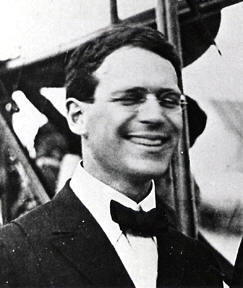 Percival Elliott Fansler, the driving force behind the St. Petersburg-Tampa Airboat Line - Pictured here on opening day, Jan. 1, 1914 Percival Elliott Fansler was a Florida sales representative for Kahlenberg Brothers, a Wisconsin manufacturer of diesel engines for fishing boats. A natural-born salesman and speed-boat racer, he was in reality an electrical engineer who had assisted in the lighting installations for the 1904 St. Louis Worlds Fair. He also sold road machinery. Due to his love of racing boats, he became fascinated with Benoist's progress in aircraft design and manufacture. He recalled later: "My appetite for speed was whetted by my experiences in racing boats." Having heard that Tony Jannus had made his famous trip down the Mississippi in a flying boat, Fansler started correspondence with Tom Benoist. Benoist liked the idea and in his reply stated that the new Benoist XIV "Safety First" airboat, capable of carrying at least one passenger--and sometimes two light ones--in addition to the pilot, would be the craft to use. Fansler said, "After receiving two or three letters that dealt with the details and capabilities of the boat, the idea popped into my head that instead of monkeying around with the thing to give 'jazz' trips, I would start a real commercial line from somewhere to somewhere else. My experience in Florida led me to conclude that a line could be operated between St. Petersburg and Tampa. The distance was about 23 miles--some 15 of which were along the shore of Tampa Bay, and the remainder over open water. I wrote to Tom about the scheme and he became immediately enthusiastic." In 1913, a trip between Tampa and St. Pete would take 2 hours by steamship, or anywhere from 4 to 12 hours by rail. The trip by automobile was an adventure, taking around 20 hours around the bay due to hand-cranked engines, solid rubber tires and unpaved roads. In November of 1913, Fansler arrived in St. Petersburg to "sell" an airline -
either to Tampa or St. Petersburg. He first made a spirited presentation
to City of Tampa officials with his business proposition--to be the
headquarters and financers of his proposed airboat passenger service
between Tampa and St. Pete. Nine out of ten thought the project was
a fake. Their belief that airboats could not fly may have been one
factor in their decision to turn down Fansler. (This, in spite of
the fact that Lincoln Beacher had flown over Tampa over two years earlier,
and one of Tampa's influential and most respected citizens, Morton Plant,
had been an original stockholder when the Wright Brothers incorporated in
1909, capitalizing their company to the tune of $1 million.) The truth of the matter was, Tampa officials didn't care whether travelers could get to St. Pete quickly and easily. Rivalry between the two cities was at the forefront, and Tampa didn't want lose visitors or their business to the city across the bay. Fansler then took the long, 64 mile train ride around the bay to St. Pete on Dec. 4th, 1913. Back then, St. Petersburg was a city of only about 9,000 people during the winter months. Fansler first used his acquaintance with former college-mate Mary Brown, wife of owner and publisher of the St. Pete Evening Independent, Maj. Lew Brown, to convince the Major of the viability of his proposal. He then made his pitch the St. Pete city officials. "They thought I had a mighty clever idea," he wrote later, "but they didn't believe there was any such thing as a flying boat. I talked a group of a dozen men into putting up a guarantee of $100 each, and the Board of Trade came in with a like amount." Along with Maj. Brown, Fansler was able to gain support from the city and other St. Pete businessmen such as L.A. Whitney and Noel Mitchell, subscribing a $2400 airline subsidy, even though there never had been a scheduled airline in the history of man. |
| FIRST SCHEDULED AIRLINE SERVICE | |
 |
Fansler immediately wired Benoist to come to St. Petersburg. On December 12, 1913,
Tom Benoist arrived in St. Petersburg. He spoke
these words, "We are going to do something here this winter which never has been
done before and which will attract attention from all the world". On
December 17, 1913, Benoist signed the world's first airline contract for
heavier-than-air planes--10 years to the day after the Wright brothers had first
flown successfully at Kitty Hawk.
The agreement called for a cash subsidy of $2,400 from the city of St. Petersburg, but only if the Benoist company supplied planes and pilots and maintained two scheduled flights daily between St. Petersburg and Tampa, six days a week for three months. Regular service was to begin on January 1, 1914. For each day that the scheduled flights were made on time, the city guaranteed to pay $40 a day through January and $25 a day in February and March. The day after the contract signing, the St. Petersburg Times reported that "a fleet of hydro-aeroplanes" would make regular trips between St. Petersburg and Tampa, and predicted that the service would "prove to be of great benefit to the city." When asked about the safety of the operation, Fansler said, "there is no more liability of accident in one of the boats than in an automobile, and the airboat will seldom be more than five feet above the water." |
|
Fansler, as general manager of the airline, fixed the price of a one-way ticket at $5 for the 22-minute trip. Passengers were allowed a maximum weight of 200 pounds gross, including hand baggage. Excess weight was charged at $5 per hundred pounds, minimum charge 25 cents. Besides operating two scheduled flights per day, six days a week, Fansler recalled that "our agreement with our backers permitted us to indulge in special flights at any price we cared to name, and we made a number of these trips at $10 to $20 each." Charter flights could be arranged from St. Petersburg to several other Florida sites--Pass-a-Grille, Clearwater, Tarpon Springs, Bradenton, Sarasota, Palmetto, Safety Harbor and Egmont Key. Advertisements for these flights stated they would cost $15 and "trips covering any distance over water routes would be made from the waters' surface to several thousand feet high at passenger request." In addition to starting the airline, Fansler announced that a training school for pilots would be established. Three Benoist airboats would be shipped from the St. Louis factory for both purposes. One was a Model 13; the other two were Model 14s. The Model 13 was to be operated by the school for instruction, and the 14s were to be used for passenger transport. Also, a large, open-ended hangar was planned.
|
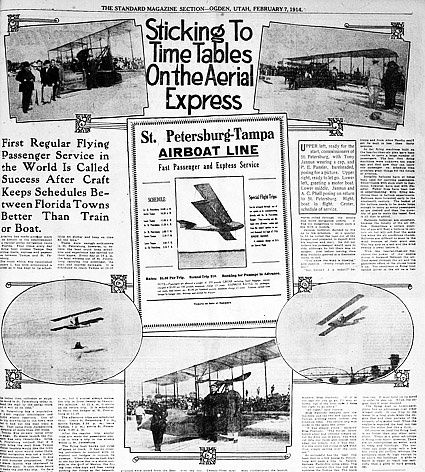 |
| The first of the two Model 14 Benoist airboats, No. 43, arrived by train from
Paducah, Ky., accompanied by Tony Jannus,
who had been selected as pilot for the line; his brother Roger, and J. D. Smith,
mechanic. Smith, whom Jannus called "Smitty, the Infallible," was
especially adept at maintaining the Roberts 6-cylinder, in-line, liquid-cooled,
75-hp engines that Benoist used in his planes. Smith had raced motorcycles as a
young man, and when he read about Benoist in 1912, he left his home in
Jamestown, Pa., for the St. Louis plant. Benoist found him voluntarily sweeping
snow off a plane in subfreezing weather and hired him on the spot. Roger Jannus, Tony's older brother, had graduated as an
excellent pilot and mechanic at Kinloch Field and became part of the airline
crew.
Upon arrival in St. Pete, the plane was promptly assembled. It weighed 1,250 pounds, was 26 feet long and had a wingspan of 44 feet. Although the plane was built to hold only a pilot and one passenger on a single seat, sometimes two small passengers could be accommodated. The hull of the Benoist flying boat was made of three layers of spruce with fabric between each layer. The Roberts engine and a pusher propeller gave the aircraft a top speed of 64 mph. The wings were of linen stretched over spruce spars. It was claimed, though not accurately, that the Benoist was the only plane in the world at the time that had the engine placed down in the hull. The plane was touted for publicity purposes as "a motor boat with wings and an air propeller." It was priced at $4,250. |
|
|
Roger Jannus, Julius Barnes, owner of the Benoist No. 43, and Tony Jannus |
| Tony Jannus gave the Benoist two test flights on December 30 and 31, 1913, accompanied on one of them by Benoist's chief mechanic, J.D. Smith, and on the other by a local man named J.G. Foley. | By New Year's Day of 1914, the continual attention the local paper was giving to the promised inauguration of scheduled flights had built up intense interest in the new venture. After a parade from downtown St. Petersburg to the waterfront, an Italian band from the Johnny Jones Show played at the municipal pier as Jannus readied the airboat for flight. A crowd of 3,000 looked on while a ticket for the first flight round-trip to Tampa on the airline was auctioned off. |
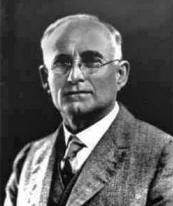
The bidding was brisk for the honor of being the first fare-paying rider. Ex-Mayor Abram C. Pheil outshouted Board of Trade Secretary L. A. Whitney, Noel A. Mitchell, and others, and for $400 the coveted ticket went to the former Inverness man. Pheil, then in the wholesale business became the world's first scheduled airline passenger. Mr. Noel E. Mitchell was second, with a $375 bid. The history-making first trip of a regular scheduled airline was about to commence.
Former St. Pete Mayor Abram C. Pheil |
|
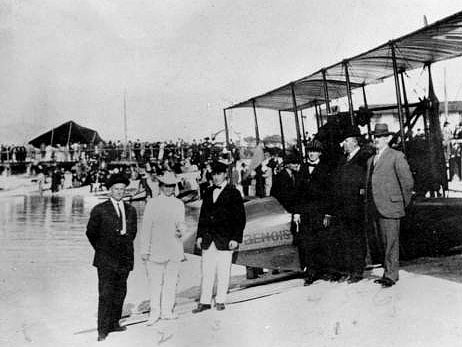 |
L. A. Whitney, secretary of St. Pete's Board of Trade, had the honor of saying a few words before introducing Percival Fansler. The flying boat was pointed towards the water, almost ready to go, while three men continued working on it. Whitney, Jannus and Tom Benoist, along with other St. Pete investors. State Archives of Florida, Florida Memory, http://floridamemory.com/items/show/32297 |
|
|
Fansler stood behind the wings while a Benoist pennant on the wing strut fluttered in the breeze. Fansler looked over the excited crowd, then spoke while the airboat was placed in the water... "The airboat line to Tampa will only be a forerunner of great activity along these lines in the near future...What was impossible yesterday is an accomplishment today, while tomorrow heralds the unbelievable," he concluded. |
| When the applause for Fansler had concluded, he introduced Tony Jannus. Jannus appeared dressed as if ready for a night out on the town, instead of a 21-mile flight in an open cockpit. He was dressed in white duck pants, a dark jacket and his customary black bow-tie, black leather gloves nearly to his elbow, and a visored cap. | |
|
When Jannus stood to speak, he was met with a tumultuous greeting. His broad smile beamed nearly as much as the emotion in his eyes. He told the crowd he would do his utmost to make this line what people expected of it. In closing, he promised to keep the maxim of "safety first" foremost in his mind. Other than the historical significance of this flight, there was nothing new to Jannus this day, having flown almost daily since his first flight in a Rex Smith plane in Nov. of 1910. Just before 10 a.m., Jannus and the ex-mayor donned raincoats. Jannus boarded the airboat, and Pheil stepped gingerly into the hull and sat on the small wooden seat beside the pilot. P. E. Fansler, Abram
Pheil and Tony Jannus, |
|
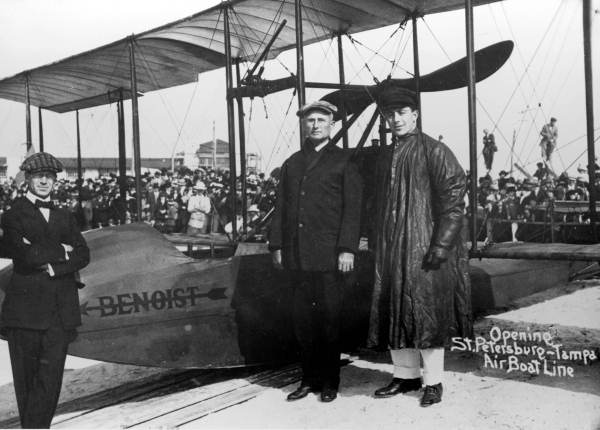
Jan. 1, 1914 - Percy E. Fansler, general manager
of Tampa Air Boat Line at the left; Mayor A.C. Phiel and Tony Jannus, pilot.
State Archives of Florida, Florida Memory,
http://floridamemory.com/items/show/26357
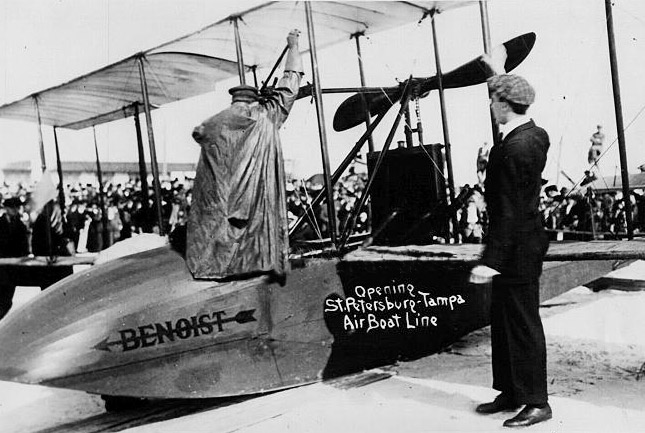
Jannus and Fansler waving to the crowds, Jan. 1,
1914
Courtesy St. Petersburg Museum of History Archives, photo no. P08410
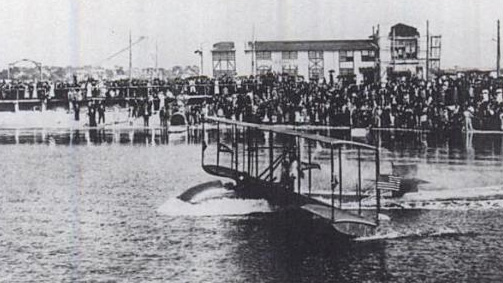 |
Jannus called out "Smitty, crank her up", starting
the two-cycle engine and Jannus tested the controls. He waved to the crowd,
taxied out and took off into the wild blue yonder and history, to the wonderment
and cheering of thousands who crowded the waters edge.
Jannus taxiing out of the St. Pete yacht basin |
|
They flew at 50 feet most of the way, but
halfway to Tampa, the engine began misfiring, and he landed in the bay
briefly to adjust it, then took off again.
Jannus & Pheil over Tampa Bay, Jan 1, 1914 |
|
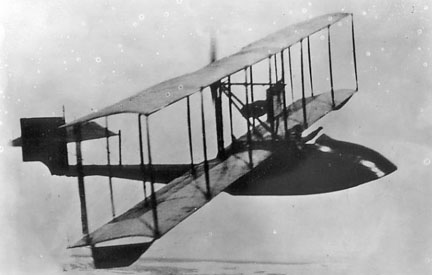 Jannus over Tampa Bay, Jannus over Tampa Bay,Jan 1, 1914
Tony Jannus on the joys of flying: "To me, flying is not the successful defying of death--but the indulgence in the poetry of mechanical motion; a dustless, bumpless, fascinating speed; an abstraction from things material into infinite space; an abandon that is yet more exciting but less irritating than any other form of mechanical propulsion." |
|
| Twenty-three minutes after the original takeoff, Jannus touched down at the entrance to the Hillsborough River, bringing it to a rest near the Tampa Electric Company plant. The excited crowd was estimated to be almost as large as in St. Pete, around 2,000 at the temporary landing dock, with another estimated 1,000 on the Lafayette St. bridge, and about 500 more across the river. |
|
|
When he reached the dock, he was greeted
by enthusiastic cheering, clapping, and the waving of hats and
handkerchiefs. A moment later, there was a rush down the three
narrow planks connecting the platform to the shore, and men, women and
children fought to get down to greet them. "Please unbutton my coat" were the
first words of Pheil after he stepped out of the cramped plane and stretched his
legs. The police had to assist in holding back the crowd so that W.C.
Burgert could take moving pictures of Jannus and Pheil bowing, smiling
and waving to the crowd. The handshakes and congratulations were
almost unending, and even Mayor D. B. McKay, who had missed a golden
opportunity to make Tampa the official headquarters of the airline,
turned out to welcome Jannus. A reporter from the Tampa Tribune asked Pheil why his hands were all greasy. He replied that it was from "assisting Mr. Jannus to adjust some machinery." He told interviewers at the time the flight caused him no nervous tension, but the ex-mayor rushed to the nearest telephone to let his folks back home know he had arrived safely.
|
|
| In Tampa, Pheil placed a several thousand dollar order for his wholesale
business. This transaction of business by air was widely chronicled in the
contemporary press.
At exactly 11:00 a.m., Jannus and Pheil left Tampa for the return trip to St. Pete. When the Benoist Airboat was sighted off the coast, word spread like wildfire. Hundreds of people crowded along the shore to gain position to view the landing. With the wind at his back, Jannus completed the return in 20 minutes.
|
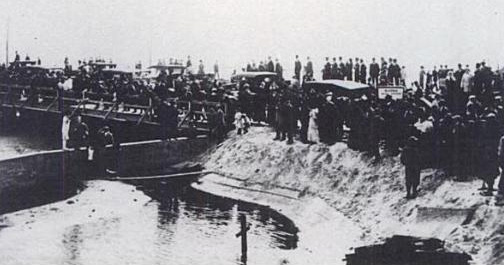 |
| Climbing from the cockpit, Jannus dropped his goggles, breaking the glass. He picked them up, plucked one of the Benoist pennants from the plane, and with a smile gave both to 10-year-old Judy Bryan who had ducked under a hastily erected rope to hold back the crowd. While posing for photos with Jannus, an elated and triumphant Percival Fansler could only utter, "So I was crazy?" Jannus was his usual calm, confident self, and remarked "It was just a routine flight." | |
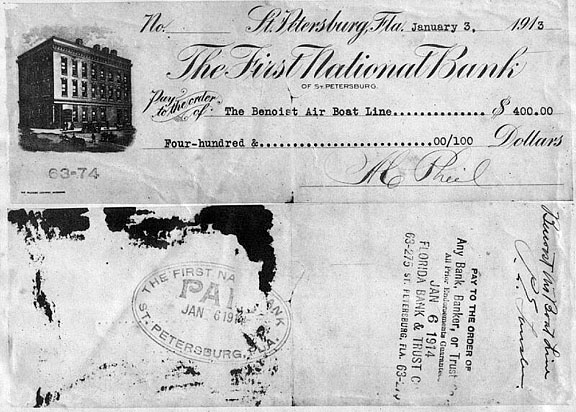 |
Abram C. Pheil's check, mistakenly dated 1913 instead of 1914. |
|
As tired as he probably was from the
flight and excitement, Jannus did not slow down. Within the hour,
he was back in the air, giving "joy-rides" to others. He took
Johnny J. Jones, for a short flight around the harbor. Jones was
no stranger to excitement. He was the owner of popular carnival
shows, featuring a flea circus, and the Regnalls, who would dive 92 feet
into a small lake of fire. Jones paid $15 for the flight around
the harbor. Later in the afternoon, Mr. Bannister, the auctioneer, auctioned off another ticket for the afternoon flight. Noel A. Mitchell was the successful bidder for a round-trip flight at $175. By the end of the day, Jannus had made 9 flights, including the 2 scheduled round trips across the bay. He carried 9 passengers, had traveled 134 miles and logged 138 minutes of flying time. A total of $615 was earned, which was donated to the city for the purchase of harbor lights. |
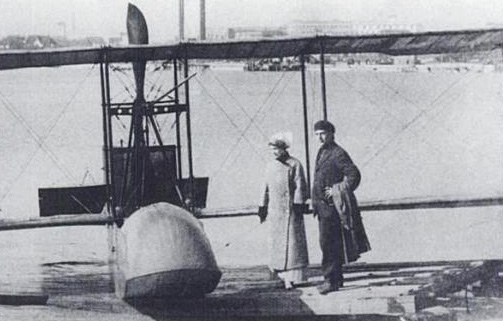 The next day, Mae Peabody of Dubuque, Iowa, was the first woman to make a local flight out of St. Petersburg. (Photos above and below) |
| The Tampa Tribune noted that the first flight
had been made "without mishap" and gave the event a banner headline in its
January 2 edition--"The First Commercial Air Ship Line Inaugurated." The St. Petersburg Times announced that it had signed a contract with the
airboat line to fly newspapers daily to Tampa, which would make it "the first
newspaper in the world to use flying machines for delivery purposes." The
announcement added, "This will be the most unusual carrier system in all the
world and Tampa readers, when they receive their copy...will read a newspaper
delivered as no other."
Exploring Florida, Courtesy of the Special Collections Department, University of South Florida |
|
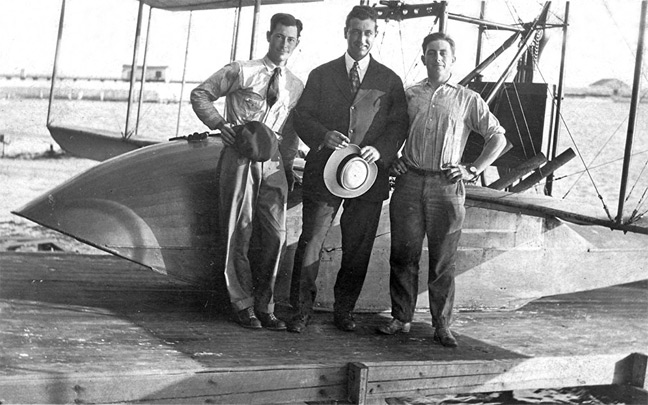
Roger (L) and Tony (R) with unknown man, circa
1914
Photo from
Shorpy.com submitted by "burmashave"
|
The Benoist No. 43 on dock at the St.Pete-Tampa Airboat Line hangar. |
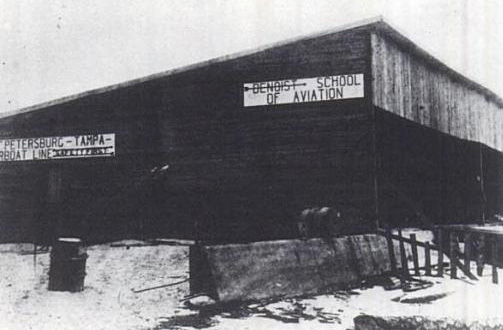 The airline, which was subsidized by Florida businessmen, made two flights
daily, six days a week. Space on the Benoist was sold out for 16 weeks in
advance when the line opened. The regular fare
was $5 per person and $5 per one hundred pounds of freight or express carried.
Shortly after the opening of the line, a new Benoist airboat was added which had
an improved front on the hull that protected its occupants from water spray
during take offs and landings. The line was then extended and flights made to
Manatee, Bradenton and Sarasota. It operated successfully for three months and
even made a night flight between St. Petersburg and Tampa carrying a Miss Marian
Ames as passenger. George Ade, the famous humorist was among many notables who
used the line. A total of 1205 passengers were carried without injury, with
only two forced landings. The airline, which was subsidized by Florida businessmen, made two flights
daily, six days a week. Space on the Benoist was sold out for 16 weeks in
advance when the line opened. The regular fare
was $5 per person and $5 per one hundred pounds of freight or express carried.
Shortly after the opening of the line, a new Benoist airboat was added which had
an improved front on the hull that protected its occupants from water spray
during take offs and landings. The line was then extended and flights made to
Manatee, Bradenton and Sarasota. It operated successfully for three months and
even made a night flight between St. Petersburg and Tampa carrying a Miss Marian
Ames as passenger. George Ade, the famous humorist was among many notables who
used the line. A total of 1205 passengers were carried without injury, with
only two forced landings. |
| The airboat line hangar was also the home of the Benoist School of Aviation, where Tony and Roger taught flying lessons. |
| The airline service had to sort out a few administrative problems. The Tampa Port Inspector required that the airline get a license for all its pilots and planes, so Jannus immediately applied for one, which was issued on February 17, 1914, by the U.S. Department of Commerce. Some historians claim it was the first airline pilot's license in the United States. According to Edward C. Hoffman, president of the Florida Aviation Historical Society, the license they have on hand has the word "steamboat" crossed out and "Aeroplane" typed in. | According to Fansler, the demand for reservations remained high: "We had a waiting list a yard long, and not once did we have to fly without a passenger." In addition to the scheduled trips, about 100 charter and sightseeing flights were reported in the two Model 14 airboats. Repair costs were stated as less than $100. An estimated $12,000 in fares was taken in, but local historians believe that the freight cost of getting the planes to Florida, employee wages and gas and oil allowed only a small profit. On March 28, as the contract expiration date neared, Benoist said, "We have not made much money, but I believe we have proved that the airplane can be successfully used as a regular means of transportation and commercial carrier." |
|
Tony Jannus and George
Gandy, Jr. Of the 50 days scheduled for flying, only seven days were lost because of weather or maintenance problems. On one flight, Jannus had to land in choppy water when the engine ran rough because of dirt in the carburetor. One pontoon and a portion of one lower wing were damaged. Fansler reported that Jannus fixed the carburetor, "got the boat into the air again with skill and flew on in with a portion of the wing hanging like the broken wing of a bird." On another forced landing due to engine problems, Jannus hit a submerged object and the boat hull sprang a leak. As Gay Blair White notes in "The World's First Airline", "This was the only case in which a passenger got his feet wet, and he would not, if he had stayed on the machine until a motor boat came out and took him off. However, as the boat had four air-tight compartments and none of these were punctured, the damage caused by the accident was trivial." |
|
|
The airline operated for another five weeks after the March 31 contract
termination date, but passenger interest declined rapidly as the "snow
birds" (winter residents) retreated northward. On April 27, Tony and Roger
Jannus flew their last flight before leaving Florida. The put on an
air race show over Tampa Bay on an
eight-mile course. Roger flew the newer, larger, 75 HP Benoist No. 45 while Tony
flew old No. 43.
Afterward, they crated up No. 43 and on May 9th they headed up to Paducah, KY by train. Tony was expecting to be called into active duty with the U.S. Volunteer Aviation Service in Vera Cruz, Mexico, but was never called. Fansler had big plans for the airline, among other ideas, he was planning to interest the U.S. Post office in "air mail", and hoped to return, but at this point it seemed improbable. |
|
| The original Benoist No. 45 had sold to Byrd M. Latham, who took it to Conneaut Lake, Pa., to provide sightseeing flights. The plane crashed in July 1914 with a 250-pound passenger aboard. Both men were thrown into the water, and the airboat was nearly destroyed. Latham salvaged the radiator and engine and built another airboat, which he named Florida. It was returned to St. Petersburg and placed in storage. | |
|
|
With the end of the St. Pete-Tampa airline, and chances of resurrecting it improbable, Tony and Roger ended their relationship with Tom Benoist. The Jannus brothers and J.D. Smith wanted to start their own flying company. For years they had flown thousands of miles in hundreds of shows, using other people's equipment. They were tired of working for daily wages as hired hands. Owners of the equipment and shows would typically earn several hundred dollars for a day of exhibitions, paying their pilots a very small percentage. Tony also questioned Benoist's integrity and worsening financial condition. Tony wanted to be known as more than a flier, he wanted to move into the design and production field of aviation, as had Glenn Curtiss, Glenn Martin and the Wrights. |
|
An air show in 1910 |
| Throughout the summer of 1914, both Roger and Tony flew many exhibitions
in the Midwest. They had a thriving business at a resort in Cedar Point, Ohio.
Using their Benoist No.43, they provided rides for guests at the Breakers Hotel,
a popular summer resort on Lake Erie. In his first 5 days, Tony flew 30
passengers over the bay and the lake, for 10 minute flights at $25 each.
He offered aerial ferry service to and from Sandusky, at $15 per round trip, or
$10 one way, and scenic trips at $1 per mile. Tony also had another
Benoist flying boat which he had bought after leaving St. Pete; he kept it
moored at the dock of the hotel.
|
|
|
|
While at Cedar Point, Tony met a young Cleveland woman named Edna Dagmar Hansen. On Friday, June 25, she flew with Tony. They then had 21 dates together until July 20th. They spent many hours together during which some times Tony played the flute, which he very much enjoyed.
|
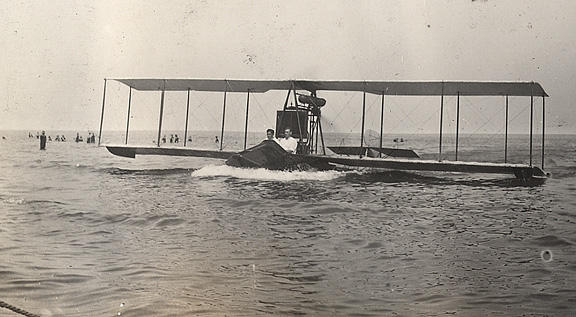
Tony Jannus and passenger
making another safe landing offshore at Cedar Point, 1914.
|
|
|
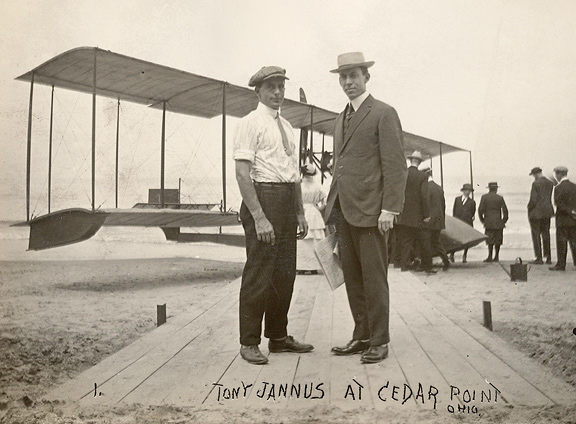
From
Ohio's Yesterdays
|
|
|
| Benoist XIV replica at the St. Pete Museum of History |
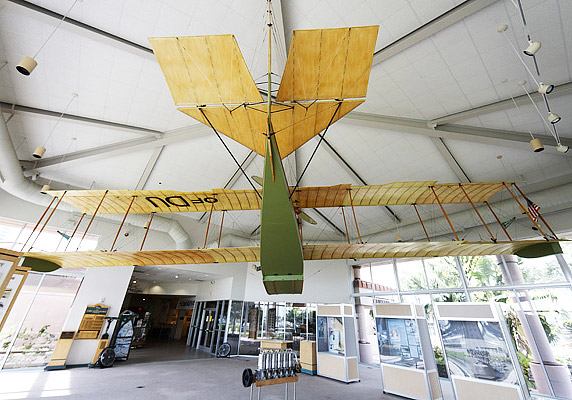 |
| In August of 1914, Roger bought the Benoist No.43 from its owner, Julius Barnes of Duluth. Following the end of summer, the Jannus brothers shipped their aircraft to Baltimore. There, they opened their own company, named the Jannus Brothers. Both brothers taught flying; Roger concentrated on exhibitions, while Tony focused his efforts on the design and construction of the Jannus flying boat. At the end of 1914, Roger Jannus, J.D. Smith and Knox Martin, new to the company, took their flying boat to San Diego in December 1914 while Tony remained in Baltimore. The California contingent did a thriving business. While at San Diego, Roger received seaplane pilot's license Number 26 from the Aero Club of America. On February 15, 1915, with Smith piloting, he crashed into San Diego bay. The passenger escaped injury, but Smith lost seven teeth. The plane was not salvageable and Jannus and Smith headed back east. Later, the former No. 45 renamed the Florida, which had suffered a broken wing, remained at St. Petersburg until 1915, when it was repaired by Smith. The plane later crashed and was destroyed with Tony Jannus at the controls. | |
| By the spring of 1915, things were not going well for the Jannus brothers. Their aircraft company, with limited production, had sold one Jannus Flying Boat, to W.E. Davidson of Detroit. While Tony was supervising the assembly of the aircraft, he considered running an engine production factory for the Roberts Motor Company. Instead, he made a side trip to Toronto. There he met with J.D. McCurdy, general manager of Glenn Curtiss's Canadian aircraft operation. Due to increased demand caused by the war, Curtiss had created a Canadian subsidiary of his American company so he could fulfill orders for the British Royal Naval Air Service. |
|
| Curtiss hired Tony Jannus as a test pilot in the spring of 1915. Under a veil of secrecy due to concerns of espionage, they worked on planes for the U.S. and Russian governments, including one called "the big machine for Russia with two 160 HP motors." | |
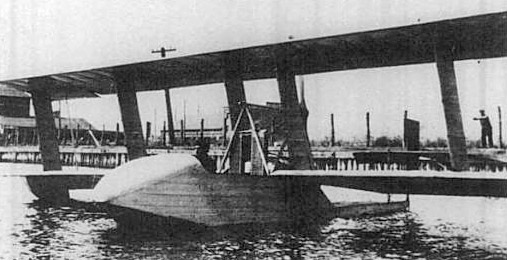 |
Jannus at the controls of the Jannus Flying Boat "Lark" in Baltimore, March 1915. Jannus may have built 2 or 3 of his flying boats while in Baltimore. The Lark was eventually sold to W.E. Davidson of Detroit, MI, and Benoist #43 was sold to Knox Martin.
|
|
|
Designed with a low center of gravity, the Jannus Flying Boat initially used a Roberts engine, but later a 125 HP Maximotor engine which was much more powerful was used. It gave the plane a top speed of 65 mph. The plane could be disassembled in 3 stages and the capability of carrying three passengers in addition to the pilot. It could carry a useful load of 900 pounds and had a range of 240 miles. |
| Roger spent the next several months flying for other people, including Tom
Benoist. While in Sandusky, Ohio, he test flew Benoist's Model G-17 boat,
two-engine, seven-passenger flying boat. In April 1916, Roger went to work for
the Curtiss Aeroplane Company and went to Russia where he engaged in diplomatic
work for Curtiss. In August, after only four months in Russia, Roger returned to
America.
Roger Jannus (far right) at the controls of a Benoist G-17, 1916. |
|
|
Death of Tony Jannus In July, 1915, Tony Jannus successfully flew the prototype Curtiss JN-3, forerunner of the JN-4 "Jenny" of World War I fame. On October 1, 1915, he was sent by Glenn Curtiss to Russia as the company's test pilot and trainer of Russian pilots flying Curtiss airplanes in combat during World War I. On October 12, 1916 at the age of 27, Jannus was flying a Curtiss H-7 near Sevastopol (then part of Czarist Russia) when his plane he was using to train Russian pilots had engine problems and crashed into the Black Sea, killing Jannus and his two-man Russian crew. His body was never found. |
The Tony Jannus Award, created to
perpetuate his legacy, recognizes outstanding individual achievement in
the scheduled commercial aviation industry and is conferred annually by
the Tony Jannus Distinguished Aviation Society founded in Tampa in 1963.
Past recipients of the award include such luminaries as Eddie
Rickenbacker, Donald Douglas, Jimmy Doolittle, C. R. Smith (the founder
of American Airlines), William A. Patterson (president of United
Airlines 1934–1966), and Chuck Yeager. Those so honored are enshrined at
the St. Petersburg Museum of History's Tony Jannus exhibit. On December 17, 2006, Jannus was posthumously inducted into the Paul E. Garber First Flight Shrine at the Wright Brothers National Memorial at Kitty Hawk, North Carolina, joining other honorees such as Wilbur and Orville Wright, Charles Lindbergh, Amelia Earhart, and Chuck Yeager, who have shaped the aviation industry.[8] The St. Petersburg concert venue Jannus Landing is named for him.
Visit the Tony Jannus Award Website |
|
Death of Roger Jannus Roger met his death in midair on September 4, 1918, at the controls of a DH-4. He had just finished flying offensive air patrols over a field at Issoudon base. His aircraft inexplicably exploded into a ball of flames. Both Roger Jannus and his student were killed. Several theories attempted to explain the cause of the explosion. It was probably because of a leaky gasoline tank. General John J. Pershing, commander-in-chief of the U.S. Army's American Expeditionary Force, cited Roger for "Bravely laying down his life for the cause of his country." President Woodrow Wilson wrote that Jannus "served with honor." France's president posthumously awarded Roger Jannus the Pendant la Grande Guerre. Roger Weightman Jannus's aviation accomplishments were many. An Early Bird flier, he was the recipient of one of the Aero Club of America's first seaplane licenses. He made history as a pilot for the St. Petersburg-Tampa Airboat Line, the world's first airline. An accomplished World War I military pilot, Roger Jannus made significant contributions to the safety of flight through actions such as development of flight training manuals and recovery maneuvers from deadly tailspins. Roger received a military burial at Arlington national Cemetery. |
|
|
|
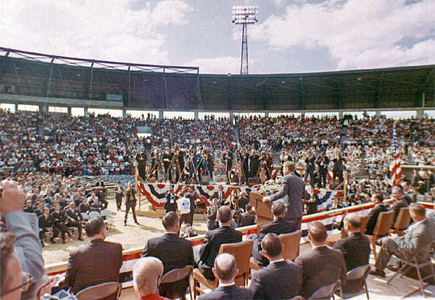
On Nov. 18th, 1963, President John F. Kennedy came to Tampa and made a speech at Al Lopez Field at an occasion commemorating the 50th anniversary of Tony Jannus' flight. His next stop after Tampa was Ft. Worth & Dallas.
Listen to an audio recording of JFK's speech at this event.
|
|
|
|
|
|
Black & white photos by Tony Zappone - See more photos by Mr. Zappone and read his memories of this event |
|
|
Sources of information and photos: World's First Winged Airline Airminded.net, the Benoist 14 First Scheduled Airline Early Aviators Jannus, An American Flyer Florida Memory Photographic Collection OhioLink Digital Resource Commons The Brief, Bright Career of Aviation's Thomas Benoist, Air & Space Museum The St. Petersburg-Tampa Airboat Line: 90 Days That Changed the World of Aviation, by Thomas Reilly, Tampa Bay History, Fall/Winter 1996 Wings Over Tampa, The Sunland Tribune, Vol. X, Dec. 1984, Tampa Historical Society
|
|